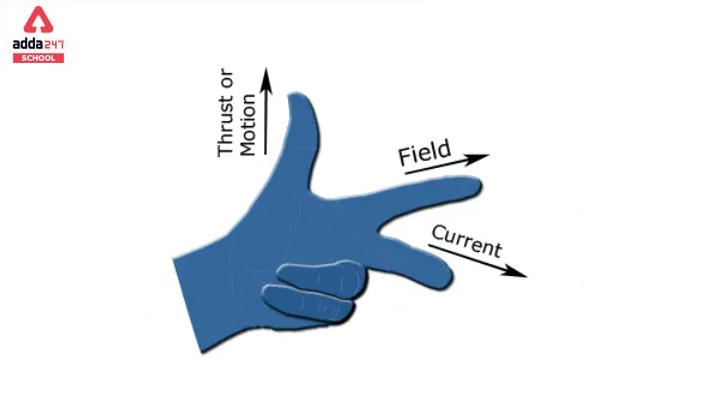Right Hand Thumb rule
The right hand thumb rule, also known as the right hand rule or the right-hand screw rule, is a mnemonic and visual aid used to determine the direction of a magnetic field, the direction of a current-carrying conductor in a magnetic field, or the direction of a force acting on a charged particle moving through a magnetic field. right hand thumb rule is widely used in physics and electromagnetism.
Here’s how the right hand thumb rule works:
- Magnetic Field around a Current-carrying Conductor: Imagine holding the conductor in your right hand, with your thumb pointing in the direction of the electric current (conventional current flows from positive to negative). Then, the fingers of your right hand will curl in the direction of the magnetic field lines around the conductor.
- Force on a Charged Particle: For a charged particle moving through a magnetic field, stretch your right hand with your thumb pointing in the direction of the particle’s velocity. Then, if you point your fingers in the direction of the magnetic field, the palm of your hand will face the direction of the force acting on the charged particle.
Remember, this rule applies to conventional current (positive to negative) and is specific to the right hand. The left-hand thumb rule can be used for situations involving negative charges or electron flow.
Using the right-hand thumb rule can help in understanding and visualizing the interactions between electric currents, magnetic fields, and charged particles, making it a useful tool in electromagnetism.
Fleming Left Hand Rule
Fleming’s Left Thumb Rules: When a current-carrying conductor is exposed to an external magnetic field, it is subjected to a force that is perpendicular to both the field and the direction of the current flow. The direction of the force exerted on a current carrying conductor in a magnetic field is determined using Fleming’s left-hand rule.
Fleming’s Left Hand Rule is Used for
According to Fleming’s Left Hand Rule, if we arrange our left-hand thumb, forefinger, and middle finger perpendicular to each other, the thumb points to the direction of the force experienced by the conductor, the forefinger to the direction of the magnetic field, and the middle finger to the direction of the electric current.
Fleming’s Left-Hand Rule Questions
The operation of an electric motor is one of the most typical and well-known implementations of Fleming’s left-hand rule. Let’s have a look at how an electric motor works:
- When an electric current passes through a conductor, a cylindrical magnetic field forms around the conductor. The magnetic field and the electromagnetic field interact when an external magnetic field is brought close to the current-carrying conductor.
- A physical force will result from the interplay of current and magnetic fields.
- We apply this rule to determine the force’s direction. The thumb of our left hand will point in the direction of the force if the middle finger of our left hand represents the direction of the current and the forefinger represents the direction of an external magnetic field.
- In a conventional DC electric motor, the electromagnetic field interacts with the permanent magnets’ magnetic field, resulting in the generation of a physical force.
- We can identify the direction of this force and the direction of the motor’s motion using this rule.
- It can be utilised to more easily comprehend the motion of any of the many distinct types of electric motors.
Difference in Fleming’s Left-Hand and Right-Hand Rules
There will be a force acting on a current carrying conductor whenever it comes into contact with a magnetic field. Fleming’s Left Hand Rule (also known as ‘Flemings left-hand rule for motors’) can be used to determine the direction of this force. The direction of motion of the electric motor is determined by this law.
Similarly, if a conductor is pulled into a magnetic field by force, an induced current will flow through it. Fleming’s Right Hand Rule can be used to determine the direction of this force. In an electric generator, this law is used to identify the direction of induced current.
Both of the Laws or rules were given by John Ambrose.
Fleming’s Left Hand Rule is Applied To the
- Fleming’s left and right-hand rule was created by John Ambrose Fleming in the late 1800s.
- When the magnetic field direction and current direction are known, Fleming’s Left-Hand Rule is a simple and accurate approach to find the conductor’s direction of force/motion in an electric motor.
- The thumb, forefinger, and middle finger of the left hand are stretched perpendicular to each other in the following manner:
- Thrust (or force) on the conductor is indicated by the thumb.
- The direction of the Magnetic Field is shown by the forefinger.
Fleming’s Left Hand Rule is Used to Find the Direction of
- The direction of the current is indicated by the centre (middle) finger.
- In an electric motor, the left-hand rule is employed to denote the direction of motion.
- There is a relationship between the magnetic field, current, and force in both Fleming’s left and right hand rules. Fleming’s left hand rule and Fleming’s right hand rule, respectively, define the direction of this relationship.
- When the direction of the other two parameters (magnetic field, current, and force) is known, these rules show the direction of any of the three parameters (magnetic field, current, and force).
- The Left-Hand rule applies mostly to electric motors, while the Right-Hand rule applies primarily to electric generators.
Fleming left Hand Thumb Rule in Physics
Fleming’s left-hand rule, also known as the left-hand motor rule, is a mnemonic and visual aid used to determine the direction of force experienced by a current-carrying conductor in a magnetic field. It is applicable to situations where the electric current, magnetic field, and force acting on the conductor are all mutually perpendicular.
Here’s how Fleming’s left-hand rule works:
- Thumb: The thumb of your left-hand points in the direction of the force (F) acting on the conductor.
- First Finger: The first finger of your left-hand points in the direction of the magnetic field (B).
- Second Finger: The second finger of your left-hand points in the direction of the electric current (I) flowing through the conductor.
To summarize:
- Thumb (F) represents the force acting on the conductor.
- The first finger (B) represents the magnetic field direction.
- The second finger (I) represents the direction of the electric current.
When using Fleming’s left-hand rule, it is important to remember that the direction of the force will depend on the direction of the current and the magnetic field. Reversing any of these parameters will also reverse the direction of the force.
Fleming’s left-hand rule is frequently employed to understand the behavior of electric motors and generators, where a current-carrying conductor experiences a force due to the interaction with a magnetic field, resulting in the generation of motion or electrical energy.
Related Post:
- Chlorine Atomic Mass And Weight In Kilo Grams
- State Difference Between Acid And Base
- Displacement Reaction – Definition, With Examples For Class 10
- What Is The Standard Meridian Of India?
- Integration Formulas List And PDF For Class 12
- Perimeter Of Triangle – Formula, Definition, Examples
- Area Of Parallelogram – Formula, Definition, Examples
- Uidai.Gov.In For Aadhar- New Registration, Update, Download









 Try CUET College Predictor 2025 to Predi...
Try CUET College Predictor 2025 to Predi...
 CUET Result 2025 OUT (Today) @cuet.nta.n...
CUET Result 2025 OUT (Today) @cuet.nta.n...
 Why the Delay in CUET UG 2025 Results? C...
Why the Delay in CUET UG 2025 Results? C...









